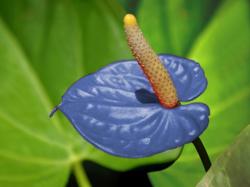Study Of pH In Anthurium Spathe Provides Clues To Generating Blues
June 30, 2011 | 2 min to read

ST. AUGUSTINE, TRINIDAD AND TOBAGO—Flower color in plants is determined by pigments such as aurones, anthocyanins, and carotenoids. Research has found that the ultimate color displayed is dependent not only on the pigment present, but also on other factors, including cell shape, presence of metal ions, and pH, among others. Information about the role of pH in creating color has allowed plant geneticists to engineer new hues, adding to the beauty and diversity of ornamental plants.
New experiments using Anthurium andraeanum, a tropical ornamental species with a limited range of spathe colors varying from orange to red, were designed to identify the most likely candidates for generating blues in the species. The study investigated the relationship between epidermal vacuolar pH and a number of factors including cultivar, spathe color, developmental stage of the spathe, location of anthocyanin within the spathe, differences between the abaxial and adaxial surfaces, and postharvest changes. The researchers noted that their long-term objective was to develop a methodology for engineering blue-colored spathes in anthurium.
"Most studies on pH have been carried out in floral tissues and limited information currently exists for leaf tissues with the exception of bracts of Poinsettia. This is the first study of pH in anthurium spathe, a modified leaf", said Pathmanathan Umaharan, corresponding author of the study. Umaharan and colleagues Omaira Avila-Rostant and Adrian M. Lennon from the Department of Life Sciences at The University of the West Indies conducted six experiments involving 23 cultivars of anthurium. The study was published in HortScience.
Spathe color was associated with vacuolar pH with the whites and greens having the highest pH followed by corals, pinks, reds, and oranges. In general, there was a correlation between the lightness of the pigmentation and the pH values, with the lighter colors having showing pH values. The values were within the pH range suitable for producing blue hues, as previously identified in three unique plant species.
The results also showed significant differences among cultivars within color categories, varying between1% to 8%, depending on the color group. "This data indicates the importance of screening a large number of cultivars within each color group to identify those with high pH for use in bioengineering of blue flowers", explained Umaharan.
The researchers said the study suggests that corals, which have the highest pH among the color groups, may be best suited as targets for transformation because they contain lower levels of pH-reducing anthocyanins.
The complete study and abstract are available on the ASHS HortScience electronic journal web site: http://hortsci.ashspublications.org/cgi/content/abstract/45/12/1768
Founded in 1903, the American Society for Horticultural Science (ASHS) is the largest organization dedicated to advancing all facets of horticultural research, education, and application. More information at ashs.org
Source: American Society for Horticultural Science
